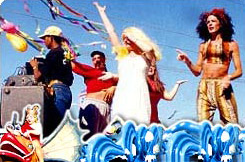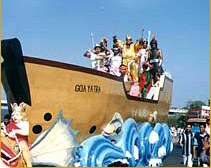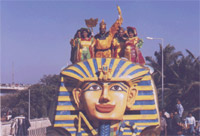 |
 The
word Carnival (Carnaval in Portuguese) is supposed to be
derived from flu- Latin Carnelevarium or rarnem levarem,
meaning "to take away meat", which actually happens
at the commencement of the 40-day penitential period of
fasting in commemoration of Jesus Christ's fasting in the
wilderness, known among the Christians as Lent, during which
abstinence from meat is a rule. The Konknni world venture,
by which it is known among the illiterate masses, comes
from the Portuguese intrude, in turn coming from the Latin
Latin Introitum, meaning entry into the Lenten period. The
word Carnival (Carnaval in Portuguese) is supposed to be
derived from flu- Latin Carnelevarium or rarnem levarem,
meaning "to take away meat", which actually happens
at the commencement of the 40-day penitential period of
fasting in commemoration of Jesus Christ's fasting in the
wilderness, known among the Christians as Lent, during which
abstinence from meat is a rule. The Konknni world venture,
by which it is known among the illiterate masses, comes
from the Portuguese intrude, in turn coming from the Latin
Latin Introitum, meaning entry into the Lenten period.
Fun and Merriment are the two main themes of Goa carnival.
Roads are jam-packed and there are three days of continuous
music, dance and fun in the delightfully cool February season.
Goa Carnival presents different shades of Goa and people
start rehearsing for the plays to be presented at the carnival
since late December or early January. The musical short
plays are composed by the natives of Goa and often are historical
in their themes. Performed by men only, the colorful costumes
and headgears of the artists surpass those worn by any primitive
tribe in Asia or Africa. Colorful processions and lavish
floats fill the streets for three days and four nights while
participants and spectators dance with the music alike.
The Goa carnival is now a social festival bringing together
the different sections of society as people dress up in
combat uniform waging mock wars with potatoes or color powders.
Young people mounted on trucks throw buckets of colored
water at the spectators. A person is chosen to impersonate
King Momo, who started the carnival, for three days and
distribute prizes to various contestants for their excellent
performances during the carnival in Goa. Goan carnival is
indeed an experience never to forget with three days of
dancing, music and extravagant fun and endless happy memories.
|
| Origin of Goa Carnival |
 The
funkiest festival of India, Goa Carnival is a three-day long
festival. King Momo introduced Goa Carnival just before the
Lent season of the Christian calendar. According to Christianity,
Lent is the 40-day period of fasting and penance before the
Easter Sunday meant to purify one's soul. An adaptation of the
Roman carnival, this tamer version in Goa usually starts off
on Fat Saturday known as 'Sabado Gordo' and concludes on Fat
Tuesday known as 'Shrove Tuesday', just before Ash Wednesday
that starts with the first day of the season of Lent. Yet the
Carnival in Goa is a madness of sorts. A few years back, it
was better known as a Christian festival and everywhere one
could see Carnival floats, balls and street dances taking over
the streets of Goa. The
funkiest festival of India, Goa Carnival is a three-day long
festival. King Momo introduced Goa Carnival just before the
Lent season of the Christian calendar. According to Christianity,
Lent is the 40-day period of fasting and penance before the
Easter Sunday meant to purify one's soul. An adaptation of the
Roman carnival, this tamer version in Goa usually starts off
on Fat Saturday known as 'Sabado Gordo' and concludes on Fat
Tuesday known as 'Shrove Tuesday', just before Ash Wednesday
that starts with the first day of the season of Lent. Yet the
Carnival in Goa is a madness of sorts. A few years back, it
was better known as a Christian festival and everywhere one
could see Carnival floats, balls and street dances taking over
the streets of Goa.
Carnival in Goa in its early days was the time when the white
masters and their black saves mimicked each other as the brown
natives watched them in awe. The whites masqueraded as black
slaves while their slaves, generally from Mozambique, plastered
their faces with flour and wore high battens or walked on
stilts. In due time, the old crude mimicry evolved into a
social satire. The native rural play-writers wrote theme for
Khel ('playi' in Konkani) while the Portuguese Governor General,
his family and retinue showered the crowds with poudre de
riz and confetti and danced with anyone who wished for a dance
with them.
In 1922, Dr. Jaime de Morais, the then Governor General of
Goa, transformed the entire area around the 'Palacio do Hidalcao'
into a 'fairy land' as he waged a mock war with the children
of Panjim from the verandah of his palace using powder bombs,
bags of perfumed powder, flowers and sugarplums. Balloons
bobbed up in the air with multicolored trails and a colorful
procession featuring horse-drawn carriages, decorated bullock
carts and gorgeously bedecked floats were the highlights during
the 3 days. Then Goa Carnival was not just a celebration.
It was a mood and was strictly for participants as people
sang and danced all nights long. The couple that fell in love
during the carnival married after Easter. Today, visitors
unacquainted with the Goan way of life are often stunned to
see the locals singing and dancing practically non-stop for
four nights and three days and drinking by the barrel without
getting drunken. Revelers greet each other with a full-throated
'Viva Carnaval'. |
| Although introduced by the Portuguese who ruled
this territory for over 50 years, from 1510 to 1961, the three-day
festival primarily celebrated by Christians, has absorbed Hindu
tradition-bound revelry and western dance forms, and stimulated
by the artistry of the Goan genius turned into a pageantry of
singular effervescence.
If down the centuries Carnaval was enjoyed only by the local
population, today its fame has crossed the frontiers attracting
thousands of people from all over India to whom this type
of extravaganza is at once riotous and different.
The participation of the Goa Government and the Municipal
Councils in it and the post-liberation introduction of the
King Memo and his colourful procession have endowed Carnaval
with a new dimenion and it is bound to attract more people
every year to this territory whose scenic beauty and white-sanded
benches have already earned Goa high praise.
WHAT TO EXPECT FROM GOA CARNIVAL
 This
festival of three days of gay abandon, riotous revelry and
merry-making now attracts to Goa thousands of tourists from
all over India. This
festival of three days of gay abandon, riotous revelry and
merry-making now attracts to Goa thousands of tourists from
all over India.
During Goa carnival, expect the air in Goa to be filled with
perfume of happiness, the roads to be jam-packed with fun
and the hearts of the people in Goa to be filled with nothing
but enjoyment and enjoyment and enjoyment. Three days of continuous
music, dance and fun. Goa is just the place to be during the
February carnival.
Most of the countries have carnivals but the unique thing
about the Goa carnival is that the people of Goa have inculcated
different items in the carnival that makes us feel the different
shades of Goa. Goans begin preparations for this grand carnival
from somewhere, say late December or early January. People
in Goa rehearse for the plays to be enacted during the Goa
carnival. These short plays are composed by the Goans themselves
and consists of music, songs and dance. The plays usually
have a touch of history to it. The cast consisting of men
only, perform the roles of women too. Dressed in the most
colourful costumes, their headgear surpasses those worn by
any primitive tribe in Asia or Africa.
On the first day, the streets of Goa are filled with colourful
processions and lavish floats and this continues for three
days and four nights. The tourists and Goans throng the streets
either to watch the procession or to take part in it. Music
rents the air and you cannot help but join the dance. It doesn't
matter who you are or what you do, the Goa carnival brings
everyone closer and it is simply fun all around.
You will find people dressed in combat uniform waging an
artificial war with potatoes or colour powders. Huge trucks
filled with young people staging various tableaus or equipped
with buckets of colored water throwing them at the spectators.
A person dresses up as King Momo and he presides over the
carnival in Goa for three days. It is King Momo who distributes
prizes to various contestants for putting in excellent performance
during the carnival in Goa.
The carnival in Goa is held for three days-three days of
dancing, three days of boundless music, three days of extravagant
fun but the memories that you gather from the carnival of
Goa is going to last a life time. The carnival in Goa is one
place to be if you want to forget all the cares in the world
and simply flow along in a river of happiness and fun.
|




